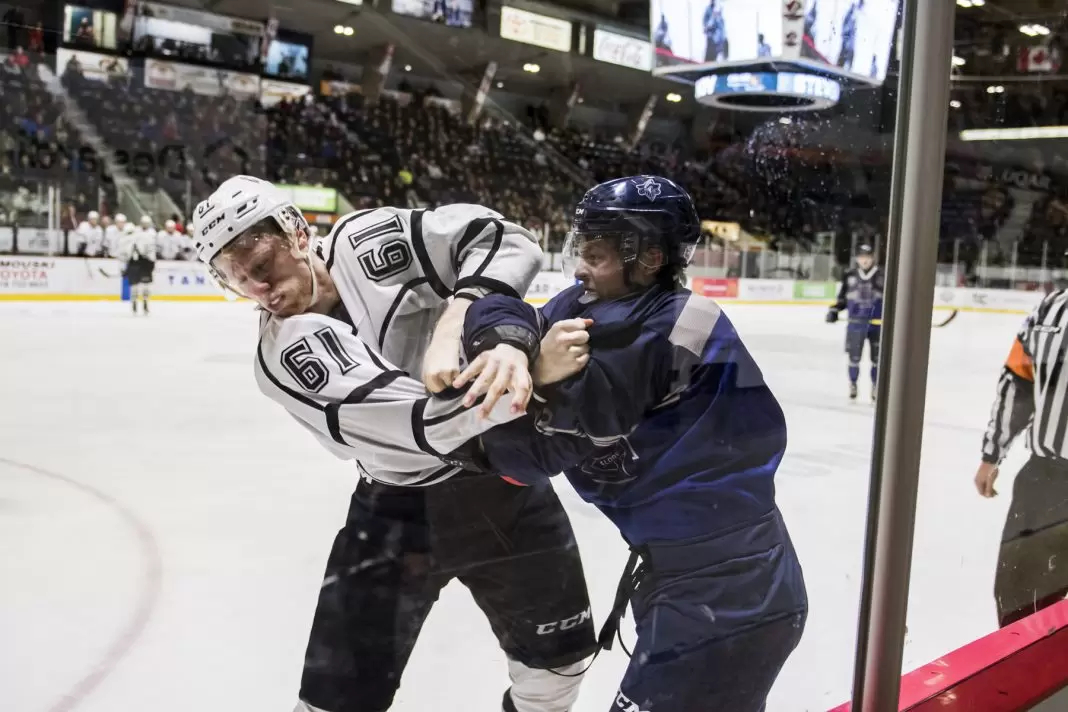We talk performance anxiety with @MaximeTruman.
“Life is a performance.” Mr. Truman
“I’ve learned a lot from losing.” JC Ouellet#faitvousvotrepropreopinion #anxiete #sports #jeunes https://t.co/IKhBYqGF7U
– CHOI 98,1 Radio X (@CHOIRadioX) November 14, 2023

Earlier this year, the QMJHL decided to “officially” ban fighting from its games. Since the start of the season, when a fight breaks out, both players are automatically ejected and the instigator receives an automatic one-game suspension.
How does it work?
We’re almost two months into the QMJHL regular season, and I haven’t heard many people say that fights are missing from the show… and from the development of young players. Quite the contrary, in fact!
183 games have been played since the start of the QMJHL campaign, and only six fights have occurred. Only Drew Elliott (Voltigeurs) has thrown down the gloves on more than one occasion… and lost both of his fights.
It has to be said that fights were already on the way out (in the Q) before this new rule. We had already gone from 0.78 fights per match a decade ago to 0.25 in 2019-20…
And last summer’s new, even more dissuasive rules have brought that ratio down to around 0.03 since the start of the current season.
A number of experts – whose mockery has made the rounds on the Web over the past year – feared that the abolition of fighting would trigger some kind of epidemic of vicious or dirty hits.

But the reality is quite different. As of November 10 – and I haven’t seen many dirty hits in the last three or four days – vicious hits are down in the QMJHL… and crowds are up by nearly 5% (despite Quebec’s economic woes and inflation).
“At a quarter of the way through the season, the circuit has recorded fewer dirty hits than last year, and its attendances are up despite the fact that we denote a drastic drop in on-ice fights.” –Kevin Dubé, Journal de Montréal
So far, Mario Cecchini, the QMJHL’s new commissioner, has won his bet, both in terms of player safety and at his teams’ ticket offices.
Society really seems to have evolved, and hockey in Quebec seems to have well and truly arrived in the 21st century. It remains to be seen whether the rest of Canada (OHL and WHL) will follow suit… and whether the reputation of Quebec field hockey players – already tarnished during NHL amateur selections and international junior competitions (CMJ) – will take another hit. I’d like to think not.
Seeing youngsters – some of them minors – fight without much protection on the ice seems to have had its day.
All that remains nowis to further reduce the number of blows to the head, which doesn’t seem so easy to do. That’s the real problem!
I know that professional hockey players are vaccinated adults (a bad analogy to make since the pandemic) and supposedly “responsible”, but every time they have the right to speak, they refuse to condemn fighting…
Except that sometimes, people have to be forced to protect themselves. Not everyone is 100% responsible. It’s up to insurance companies, the Players’ Association and management to take action ...
Ah yes… no one’s going to trot out the argument that abolishing fighting would increase the number of dirty hits in the NHL: we have proof with the QMJHL – as well as the NCAA and multiple European junior leagues – that it’s not true. #FakeNews
In closing, Brandon Duhaime and Luke Kunin are among the players who threw down the gloves most often in 2023-24 in the Bettman circuit… and they didn’t play in a circuit where fighting was allowed before signing pro.
The WHL and OHL need to follow the QMJHL’s lead, and fast! Then maybe we’ll tackle professional hockey. But I see NO reason why underage kids should continue to beat the crap out of each other in Ontario or Western Canada.
Extension
– We always have really interesting discussions when JC, Patricia and Pierre have me over for lunch.
– CPL is a really interesting product. Too bad we don’t have any teams in this league in Quebec…
Ever wondered what coaches say at halftime? Here’s a look at what Bobby Smyrniotis of @ForgeFCHamilton and @tommywheeldonjr of @CPLCavalryFC said at halftime of the CPL Final
Full documentary: https://t.co/7S9WB69ATe
Watch every #CanPL match on @onesoccer
pic.twitter.com/NtnnmfDW4O
– Canadian Premier League (@CPLsoccer) November 13, 2023
– I love it! Let’s get him to sign his next contract in the next few hours!
@CanadiensMTL goaltender Samuel Montembeault played old-school street hockey yesterday in Old Montreal. A photo shoot and a great interview that you can discover in our “goalies” special on December 7. Thanks “Monty”! pic.twitter.com/nfxVT2gf17
– Hockey Le Magazine (@HockeyMagazine) November 14, 2023











